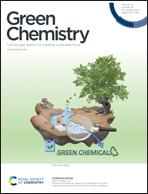A gravity-driven high-flux catalytic filter prepared using a naturally three-dimensional porous rattan biotemplate decorated with Ag nanoparticles†
Abstract
Plant-based natural biotemplates are increasingly gaining popularity for the development of catalytic filters in water treatment owing to their unique features, such as exquisite microstructures, renewable properties, and environmental friendliness. However, the development of catalytic filters, not limited to plant-based filters, to achieve both super-high water flux and excellent treatment efficiency, particularly under gravity-driven conditions, remains challenging. Therefore, herein, an efficient gravity-driven catalytic filter was fabricated using a naturally three-dimensional (3D) porous rattan biotemplate for water treatment. After reducing Ag(NH3)2+ ions via an in situ process that did not involve the addition of reductants or stabilizers, Ag nanoparticles (NPs) were immobilized in the inner microchannel of the porous rattan cane. The intrinsically aligned microchannels in the vascular bundles of rattan (diameter 24–420 μm) acted as reaction compartments for the immobilization and stabilization of Ag NPs. Furthermore, the 3D Ag/rattan filter exhibited excellent gravity-driven catalytic activity (up to 97.2% treatment efficiency for a high water flux of 7471 L m−2 h−1), good recyclability, high water permeability, and stability toward 4-nitrophenol reductions. These excellent properties were attributed to the synergistic effect of the evenly distributed nanosized Ag catalysts and microchannel structures of rattan. Rattan materials are abundantly available and naturally porous, and they can readily serve as cost-effective, nontoxic, biodegradable, and sustainable sources in numerous catalytic applications.



 Please wait while we load your content...
Please wait while we load your content...